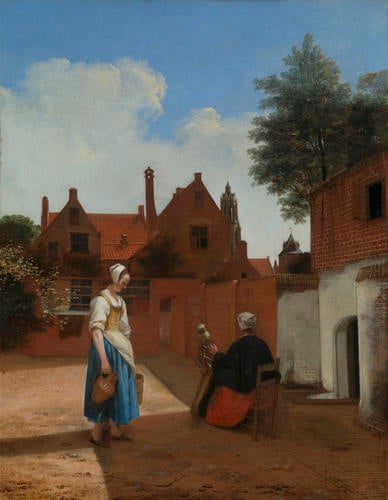-
1 of 253523 objects
A Courtyard in Delft at Evening: a Woman spinning 1657
Oil on canvas | 69.3 x 53.8 cm (support, canvas/panel/stretcher external) | RCIN 405331

Pieter de Hooch (Rotterdam 1629-Amsterdam 1684)
A Courtyard in Delft at Evening: a Woman spinning 1657
-
A Courtyard in Delft, acquired by George IV in 1829, is a precious record of a moment when Pieter De Hooch and Johannes Vermeer were both working in Delft, evolving a distinctive style. Evidence of dated works (like this one) suggests that De Hooch was leading the way. This painting is one of de Hooch’s earliest treatments of the subject, dated 1657 on the evidence of a signed and dated copy (Private Collection). It is also one of the most atmospheric in the portrayal of the shadows filling the foreground. Thus, de Hooch contrasts the seated figure seen in shadow with the standing figure who is walking from the sunlight into shadow. On the vertical axis there is a similar shift from the bright blue sky overhead to the darker tones in the lower half.
The viewer is invited to enter what is essentially a private world. Both women are preoccupied by their simple domestic tasks. Even so, this private space partakes of a more public context. On the right beyond the house can be seen two towers: the taller one that of the Nieuwe Kerk (New Church), where William the Silent, the founder of the Dutch Republic, is buried, and the smaller one that of the Stadthuis (Town Hall). Another important feature of A Courtyard in Delft is the close observation of the buildings, both as regards the materials from which they are constructed and the tonal relationships (especially the reds) of their silhouetted forms. Most convincing is the patchy distribution of the whitewash on the brick and the different types of mortar and pointing seen in a varying light. The gabled house flanking the tower of the Nieuwe Kerk can be made out in other courtyard paintings by de Hooch, adding to the sense that the artist devised his compositions within a tightly knit area that he knew intimately.
While his reputation was certainly enhanced by the 'discovery' of Vermeer in the 1860s, De Hooch was already a sought-after name in the time of George IV, who owned two paintings by the artist: A Courtyard in Delft and The Card-Players (CW 85, RCIN 405951). Both paintings were recorded in the 1819 inventory of Carlton House and were correctly attributed and impressively valued (CW 85, 405951 at 700 guineas; this one at 400 guineas).
Signed lower left corner: 'P.D. HOOCH'
Catalogue entry adapted from Enchanting the Eye: Dutch paintings of the Golden Age, London, 2004Provenance
Acquired by George IV in 1829; added to the Carlton House inventory dated 1819 (no 627); in the Picture Gallery at Buckingham Palace in 1841 (no 126)
-
Medium and techniques
Oil on canvas
Measurements
69.3 x 53.8 cm (support, canvas/panel/stretcher external)
86.2 x 71.0 x 7.0 cm (frame, external)
Other number(s)